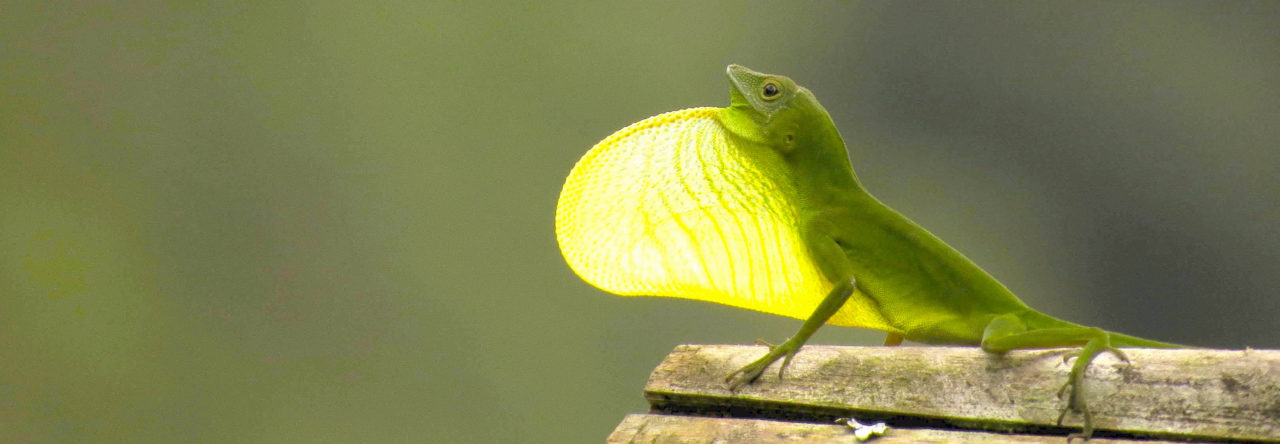Two-tailed–or occasionally even three-tailed–lizards are not all that uncommon. The way it usually happens is easy to explain. Most lizards can lose their tails and regrow a new one. The way they do this is that in the middle of each vertebra in the tail is a zone of weakness (called a “breakage plane”), pre-made to easily fracture. At the same point, the muscles are arranged to pull apart, and the blood vessels to easily split and clamp down, losing little blood. When this happen, the signal goes out–don’t ask me how–and new tail construction begins.
But occasionally it doesn’t quite work like this. The tail is only partially broken, and doesn’t come off, but enough is broken that new tail growth begins. The result: two tails, the old, still attached one, and the newly grown one.
Now, one more point: new tails do not regrow the original vertebrae, made of bone. Rather, they grow as one long, cartilaginous rod. So, one can easily tell the new tail from the old one.
In any case, that’s how I understood things. When we caught the beauty pictured above, I thought “let’s x-ray the tail to illustrate how this happens for our viewing audience back home.” And boy was I surprised. Take a close look–both tails are composed of cartilage–no bones there.
Now, you’re probably thinking: “Big whoop. It lost its tail, regrew it, then partially broke the regenerated tail, leading to the production of a second one.” Well, you’re probably right, but it’s not supposed to happen that way. Regenerated tails do not have breakage planes and other adaptations for detachment. They’re not supposed to be lost and regrown. Can anyone explain to me what’s going on here?
- Evolution in Real Time on Lizard Island - March 23, 2025
- Spider Snags Adult Anolis osa - March 22, 2025
- An Homage to the Green Anoles of New Orleans - March 21, 2025




Ludovic Deutsch
An (died) Anolis porcatus in captivity to a friend of mine
http://i64.servimg.com/u/f64/12/24/20/61/a_porc12.jpg
Thomas Sanger
If a predator (or human) was to pull on the rejuvenated portion of the tail would it break at a random segment or at the first available breakage plane? While seemingly improbable, this morphology might be possible if there are breaks in subsequent vertebrae. Maybe?
Bill Bateman
Y’know, you’re right; it’s NOT supposed to happen that way. But it does. In brown anoles, in sand skinks, in pygopodids, in lots of things. There’s a project there…
Liam Revell
Yes, I believe we also found evidence of this in our study of tail autotomy and regeneration in several Puerto Rican anole species.
Ramon E. Martínez-Grimaldo
I also found an Anolis sericeus with the same situation. But I don’t take a x-ray.
Don Lyman
Of the nearly 300 A. pulchellus and A. krugi I’ve x-rayed at the MCZ labs I’ve found two specimens with double tail tips. I’d have to recheck the x-rays, but as I recall neither of them looked as though the tail had been broken. It looked like they just developed that way initially. Obviously different from the x-rays/scenario presented here.
Gehesh
Hello,
Just yesterday I observed one lizard two tails. I was quite excited and took the photo.
I thought that was a rare phenomenon and was googling to see if anyone else has seen it.
So did you get an answer for your question? Is it grown from the beginning or after the tail cut escape activity?
Derick
…same reason I’m here! Quite freaky at first glance. Just checking here before releasing…
Anybody interested in studying it?
iyenoma paul osahon
have seen the lizard with two tail,why must the second tail grow from another direction.
Karen Allsbrooks
My twin 8 year old grandchildren love lizards and found this lizard. We researched how two tails are grown, but this one looks like they both might be cartilaginous. What do you think? This is a fence lizard, found in middle Tennessee.
Jonathan Losos
It does. Looks like it was two-tailed, then possibly lost its original tail, regrowing a second cartilaginous tail.
Christie
I saw this one today.
Patrick
Here’s my little two tailed friend who’s been on my stoep for weeks now.
Tony Gamble
Very nice, Patrick! That looks like Afrogecko porphyreus. Where did you find her?
Patrick
I live in Cape Town, South Africa. We have tons of them living outside our house.
vasundhra sheffali
we saw a two tail lizard in our hostel rum
Kenneth Setzer
Here’s one with three branches spotted in Coral Gables, Florida. This was within the last year. Anolis distichus, I think.
SUNIL
I have two tell lizard
Peggy
I live in Clearwater for 4 yrs. we have brown and black lizards, night time geckos. My question is we are finally getting baby green lizards that t prefer . Is there anything I can do to encourage the green population?
shelton
im an eye witness. i saw three of these lizards first was in sept 2015 ese were e first one with two tails then another with three yeaterday afternoon i saw yet the third one with two tails with the smaller one in the early stages of growth.
aaron
very big tails!
michael kaura
i have find one two tail lizard , if anyone interest
please let me know.
Tracie Munzi
Perfect split or regrowth or whatever happened.
Charlotte Battles`
There’s a two-tailed lizard on my porch. I suspect it is from eating all the GMO insects from the surrounding GMO fields.
JARDON JAMES
I live with one here in Jamaica and I’d love to understand him/her. I don’t study lizard so I need help lol. Any one ??